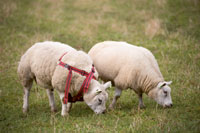Over-fed rams doing sheep industry massive harm

The culture of paying excessive prices for over-fed rams selected on looks and lasting only a couple of seasons will have to change if the UK sheep industry is to make real genetic progress.
That was the blunt message hammered home by speaker-after-speaker to more than 100 sheep farmers attending a Scottish Agricultural College (SAC) ram feeding workshop at the Moredun Institute, Edinburgh.
“Most rams are sold in over-fat condition as a result of heavy concentrate feeding,” said SAC sheep specialist, John Vipond. “The biggest rams make the highest prices, but they are often unfit for breeding in their first year and future performance is compromised.
“Sellers are simply responding to the price signals from buyers and overfeed to meet the demand for size. But buyers are not happy with the performance and longevity of rams.
“We need to identify ways of breaking this deadlock to the benefit of the industry and sheep performance.”
The average working life of a ram was often no more than two seasons – when three or four seasons should be easily achieved, he said. And a ratio of one ram to 40 ewes was way below the 1:100 ratio, or even 1:150, which was normal practice in New Zealand.
“Financially, a sire’s mating capacity and longevity is at least as important as his genetics,” said Dr Vipond. “A £550 shearling ram which works for four seasons and serves 100 ewes producing an average one-and-half lambs reduces the ram cost by £3.66 a lamb at current prices compared with a ram lasting for only two seasons and serving only 40 ewes.”
In addition, a good terminal sire, selected on performance rather than looks, could be worth an extra £2 a lamb, while a good maternal sire could boost the income a ewe by £6-£12 in a ewe’s lifetime.
Dr Vipond said it was ironic that traditional breeders selecting on breed characteristics with no commercial value, such as size of head, strength of bone and colour, were being better rewarded than those selecting for performance traits and lamb vigour at birth.
As a result, they were in a better position to make use of expensive science-based technologies, such as embryo transfer and artificial insemination, but little genetic progress was being achieved because rams were being selected on the basis of concentrate feeding rather than grass.
Rams were not lasting because overfeeding concentrates resulted in a variety of detrimental physiological effects which affected rumen function, increased body and liver fat, impaired skeletal development and reduced sperm quality, SAC’s John Robinson, told the seminar.
“Grass, supplemented with minerals, is by far the best feed for producing rams which are fertile, active, long-lasting and capable of serving 100 ewes in a season,” said Prof Robinson.
New Zealand sheep breeder, Murray Rohloff, said UK producers would have to become more efficient to survive in the face of likely cuts in EU support.
“You need to follow the New Zealand experience and concentrate on rigorous culling and improving genetic selection rather than constant moaning about things beyond the farm gate that you can’t change,” he said.
“Unless commercial farmers demand easier-care traits, and genes for continuing productivity, nothing will change to prevent the UK sheep industry from decline,” he warned.
